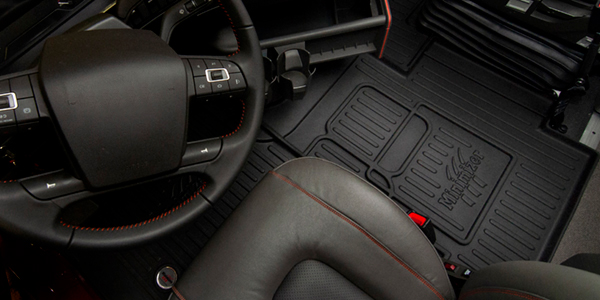Mandates to reduce emissions and improve performance of on-highway heavy-duty diesel engines in the past decade have spurred enhancements in filtration products. Filter technology developed for modern high-heat generating engines, for example, can also improve the performance of older heavy-duty vehicles, as well as help to reduce emissions. The requirements for cleaner air and fluids in the new engines has resulted in filtration products that can pay dividends in the form of extended preventive maintenance intervals for older vehicles. Many of these newer products can be substituted for the standard replacement filters with few or no changes to the existing engine plumbing.
While this list is by no means all-inclusive, the following products have been recommended by their manufacturers for their performance benefits in older heavy-duty vehicles.
Oil filtration
One of the issues affecting post-2002 diesel engines using enhanced exhaust gas recirculation (EGR) is increased oxidation and acid in the oil. To counter this and the resulting oil total base number (TBN) degradation, FRAM, part of the Honeywell Consumer Products Group, is introducing its new Oil Management System (OMS) through Mack OES with the Genuine Bulldog Time Release Technology (TRT) filter. This new filter impedes the degradation of an oil’s TBN, thereby helping to maintain that important oil quality longer. According to Kenny Cameron, FRAM commercial vehicle/heavy-duty filtration product manager, the patent-pending design, linear-release rate technology of the new filter gradually releases additive to replenish oil TBN, thus potentially reducing the amount of oil changes needed annually. “If you amortize that over a large fleet of trucks,” says Cameron, “it’s quite a savings when you consider downtime, cost of oil, cost of labor and other elements involved in an oil change. Additionally, less oil changes results in reduced waste streams which include not only oil, but filter disposal as well, which is good for everyone.”
Cameron also notes, “In an evolving fleet maintenance environment, extending oil changes with time release technology will require oil sampling and diagnosis –– that’s a must.” To meet that demand, FRAM recently introduced its new Fluid Analysis Program through its partnership with Polaris Labs Inc.
By special arrangement, the Genuine Mack TRT Bulldog filter is available for many pre-2007 Mack engine applications. Similar TRT FRAM-branded filters may be available later this year for Detroit Diesel, Cummins, Caterpillar and International engines. All this has the intent of offering fleets solutions to escalating fleet maintenance costs.
Donaldson Co. Inc. offers its Endurance oil filter product line that, according to Brian Tucker, engine liquid product manager, “supports users that have an extended drain strategy through their oil and equipment manufacturer, such as using a synthetic oil” –– and are looking for longer-lasting filters to support that. The Endurance Plus product line is for end users that would like to go to extended drains, but would like to use standard mineral-grade oils. “Endurance Plus is a filter that combines the long-life features of the Endurance product line with an additive package that is reintroduced to the engine oil to allow that base stock mineral oil to last longer,” Tucker explains. This product is guaranteed up to two times the drain interval, up to 60,000 miles (some restrictions apply; see www.expectmorefromyouroil.com for details). The product line covers Caterpillar, Cummins, Volvo/Mack and Detroit Diesel Series 60 engines. A bottom line calculator at www.donaldson.com allows one to type in fleet size, mileage and change interval and calculate savings based on engine, labor and oil cost.
“A filter’s primary function is to trap and hold contaminants,” according to Brad Drake, technical writer for WIX Filters. Beyond this baseline protection are products like WIX’s XD (extended drain) and XE (extra efficiency) oil filters. “These filters, in combination with an oil testing program,” says Drake, “is where you’re going to achieve your greatest potential for extending service intervals.”
Bypass oil filtration
Bypass filtration is a filter added to the lube system that is designed to have a higher efficiency at removing smaller-size contaminants than the full-flow filter. A bypass filter also increases the system’s contaminant retention capacity, resulting in cleaner engine oil and allowing longer oil drain intervals.
According to David Cline, oil filtration product manager at Parker Hannifin’s Racor Division, older engines produce more soot. The small particles, one to four microns in size, that bypass filtration captures, are those that can get trapped in between piston rings and cylinders. With contaminant particles under control, oxidation and acid levels, monitored by oil analysis, indicate when to change the oil rather than an increase in contaminants, notes Cline. The additional plumbing required for a Racor LFS 800 series bypass filter is minor –– a hose kit to connect the filter inlet and return oil to the engine –– and the installation typically takes an hour to an hour-and-a-half.
SPX Filtran offers a spin-on, full-flow diesel engine oil filter with integral bypass media for heavy-duty truck applications. Its DoubleDuty filter’s patented double filtration technology can extend oil service intervals two to five times normal rates, the maker says.
The DoubleDuty filter removes contaminants larger than 20 microns during full-flow filtration, while particles as small as four-micron size, including soot, are removed with 99 percent efficiency using PartialFlo integral bypass filtration. By removing the smallest contaminants possible, the lube oil lasts longer, allowing longer oil change intervals and extending filter life. The complete filtration system is contained within the same size package as an OE design filter. A single SAE-4 hose and fitting added to the existing engine port allows the oil to return directly to the engine, with no remote-mount bypass filter system required. The company also has developed custom drain intervals with full analysis and particle counting on all oil samples, which is especially useful for analysis of higher mileage engines. SPX’s OilTracker service can verify oil cleanliness and oil change interval dates with personalized data and trending summary reports.
Crankcase ventilation
Crankcase ventilation (CCV) products filter the “blow-by” (the mixture of oil mist and fumes blown passed the piston rings into the crankcase) that otherwise might exhaust into the environment or cause a fire hazard under the hood. Newer engines require a closed system, but on older engines, crankcase fumes simply run out of the rocker cover via a breather or draft tube into the atmosphere. A CCV filter closes the loop by coalescing oil droplets from the fumes, returning these to the oil system, and returning filtered air back to the engine intake system. David Tice, Parker Hannifin Racor Division CCV product manager, explains that the filter’s media traps soot and other contaminants as the oil is separated from the air.
CCV filters help to prevent clogging of engine intakes, turbochargers and intercoolers, reduce smoke and odor, and decrease environmental pollution from crankcase emissions. Typical service life is 750 hours for most applications, says Tice, allowing fleets to schedule routine maintenance with other tasks.
CCVs are available for almost every engine application. Donaldson’s solution is its new Spiracle Crankcase Filtration System (CFS) with proprietary Synteq media that has a lower operating pressure drop, higher overall efficiency (95 percent) and longer life compared to traditional media, according to the company.
Air filters
Dan Adamek, director, engine filtration for Donaldson Co. Inc. notes, “More people are recognizing the importance of high efficiency levels on the air intake system as a means of protecting the engine and decreasing wear.” Donaldson’s next-generation PowerCore G2 air filtration solution offers Ultra-Web nanofiber filter media technology as a means of achieving a higher efficiency level, says Adamek, thereby decreasing the amount of contaminant in the engine and decreasing wear.
PowerCore G2 can provide a matrix of performance advantages, including smaller size (30 percent smaller than the original PowerCore due to higher packaging efficiency), lower pressure drop, longer filter life or a combination of all three. By reducing the restriction on the intake system, there are engine efficiency gains to be had with higher horsepower. It’s made in sizes for a variety of applications in OE brands and available to the aftermarket through Donaldson.
Steve Carter, product manager, engine filtration for Donaldson, notes similar advantages for the company’s Endurance air filter line, “which is typically a pleated filter element cartridge that replaces a standard efficiency air filter element. It also provides typically a longer life in on-road applications where soot is the primary contaminant.” Carter adds, “Elements last longer so there’s less waste, less cost –– and we’re throwing away less.”
Donaldson guarantees its Endurance air filters will go twice the distance of competitive cellulose air media filters, allowing extended change intervals in on-highway truck fleets or the company will supply a new filter at no charge. Qualifications apply, so see the website for complete details.
Fuel filters
Water in fuel is serious problem, and biodiesel can hold more dissolved water than can ultra low sulfur diesel (ULSD) fuel. Racor has developed its 700 Series Integrated Fuel Filter/Water Separator for Class 8 trucks with a two-stage filtration and priming system. The 700 Series Electric Primer Pump –– available in 12v and 24v –– allows the system to be primed with the push of a button. The 700 series comes in four different flow rates and can be used as a retrofit kit for older vehicles, according to Katie Coury, filtration pump product manager, Parker Hannifin Corp. Racor Division.
Coolant filters
“Forty percent of engine downtime is cooling system-related,” notes Chris McKenzie, director of marketing for the Penray Co. One of the main coolant additives to be depleted is nitrite, which helps form a protective barrier on metal parts. The Penray Need-Release Extended Life Cooling System Treatment goes beyond filtration by releasing Supplemental Coolant Additive (SCA) as needed. The patented membrane technology senses the coolant’s increased corrosiveness, then allows the release of up to four separate additive pellets to keep the cooling system protected. “The difference is that similar products are time-released,” says McKenzie. “They’re not based on changes in chemistry, as is our product.” Need-Release filters can last 150,000 miles, 15 months, or 3,000 hours, according to McKenzie. This saves on labor costs and filter inventory, as well as offering less chance for maintenance mistakes. Models are available to fit Detroit Diesel, Caterpillar, Cummins, Ford, Mack and Volvo engines with 8 to 20 gal. cooling system capacity.
The future of filtration?
Hengst of North America Inc. is expanding its heavy-duty presence in the U.S. with agreements to include its multifunctional fluid management modules as OE on Mercedes-platform Daimler and Detroit Diesel (DD15) engines as well as International MaxxForce engines. The Energetic on-engine modules combine oil filter and cooler systems, coolant pump, fuel filter, fuel heater and controls mounted in one location, reducing weight and needing fewer connecting lines. The system’s top-accessible replaceable elements make filter changes easier and cleaner for techs. Since the cartridges do not include any metal, they can be disposed of in more environmentally friendly ways.
Stephan Schlottoff, head of sales and marketing for the company’s North America aftermarket suggests –– based on input from Hengst’s European engineers –– that maintainers of older trucks use synthetic oil and high-quality filters. These will help you justify going longer distances between drains, Schlottoff says, which can help save you money.




